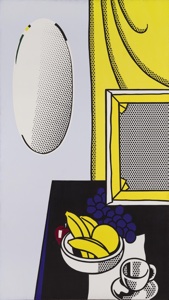Roy Lichtenstein ( 1923 - 1997)
Still Life with Mirror
1972
Oil and acrylic on canvas
Crystal Bridges Museum of American Art, Bentonville, Arkansas. Photography by Edward C. Robison III.
Contemporary Art Gallery
Description of Still Life with Mirror
NARRATOR: The painting that you are in front of is entitled Still Life with Mirror and was made in 1972 by Roy Lichtenstein using oil and acrylic paint on canvas. It is 96 inches tall and 54 inches wide and depicts a cropped view of a still life with everyday objects on a table with a curtain and a mirror in the background. The painting is displayed in a slim, wooden frame that spans roughly from one foot above floor level to five feet over one’s head.
The bottom right portion of the painting features the top of the black table that is turned almost parallel to us as we stand in front of this painting. If this table top existed in real life, all of the still life objects that rest on it would crash to the floor because of the angle.
Near the bottom right corner of the table sit a white tea cup and saucer that rest partially on a white napkin. The napkin is turned at the same unusual angle as the table. On top of the upper left corner of the same napkin rests a rounded white bowl filled with yellow pieces of fruit, which include three bananas and what appears to be an orange.
Peeking out from behind one of the bananas on the left side of the bowl, we see part of a red apple with a bold white highlight. There is also a clump of dark blue grapes located on the right side of the bowl.
Behind the grapes and located near the upper right corner of the table, we see the back of a picture canvas. The wooden stretcher of the canvas is bright yellow, and the canvas that is wrapped over part of the stretcher is stark white.
Behind the canvas stretcher and reaching to the upper right portion of the painting, there is a bright yellow curtain. An oval-shaped mirror hangs on the pale gray wall to the left of the curtain.
The artist, Roy Lichtenstein borrowed elements of commercial art to create this artwork. Rather than using carefully blended highlights and shadows to make the objects in the painting look more realistic and three-dimensional, he painted each object as a flat area of color. He kept his color palate for this painting very simple by using only red, yellow, blue, black, or gray as the color for each object. Many of the objects in the painting are outlined with thick black lines similar to what you would find in a comic book. Lichtenstein also uses a series of black dots placed closely together in order to create shadows on some of the objects, including the right side of the mirror, the back of the canvas stretcher, the bottom of the fruit bowl, and inside the cup and saucer. This technique is also used to create shadows or complex colors in comic books.
[End of Stop]



